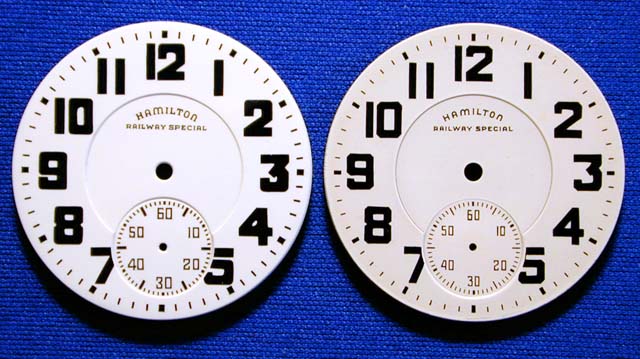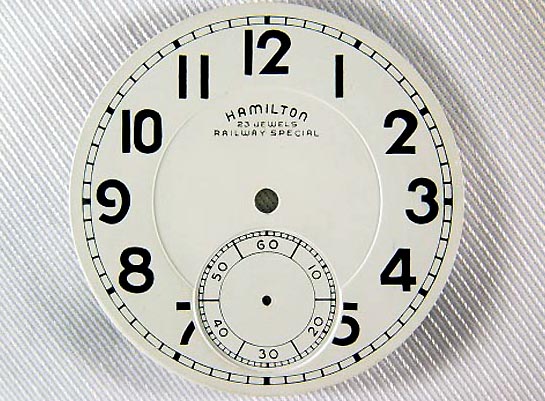
| WWT Shows | CLICK TO: Join and Support Internet Horology Club 185™ | IHC185™ Forums |

|
• Check Out Our... • • TWO Book Offer! • |
Welcome Aboard IHC185™  Internet Horology Club 185
Internet Horology Club 185  IHC185™ Discussion Site Main Page
IHC185™ Discussion Site Main Page  Open to the World RESEARCH FORUMS
Open to the World RESEARCH FORUMS  Hamilton and 992B Research Forum
Hamilton and 992B Research Forum  Railway Special Dials
Railway Special Dials
 Internet Horology Club 185
Internet Horology Club 185  IHC185™ Discussion Site Main Page
IHC185™ Discussion Site Main Page  Open to the World RESEARCH FORUMS
Open to the World RESEARCH FORUMS  Hamilton and 992B Research Forum
Hamilton and 992B Research Forum  Railway Special Dials
Railway Special DialsGo  | New Topic  | Find-Or-Search  | Notify  | Tools  | Reply to Post  |  |
I may need to make a trip to Columbia to find information on the subject, but maybe someone has knowledge on this topic. When Hamilton went to the Melamine dial, is anyone aware of any customer feedback? The diffence in appearance of the quality is significant, there had to have been "pushback" from the railroad traditionalists, or was it considered a space age improvement? Thoughts anyone? | |||
|
| IHC President Life Member |
Matthew, I've often wondered about this subject as well. We look at these dials today and see faded gray, often badly cracked examples. However, every now and then a nice one shows up. Oddly enough, they probably looked a lot like porcelain dials when first released. Some early ones look pretty good, in fact they might fool us at first glance. The earliest ones had a glossy finish but many of them cracked badly. The later ones have a chalky appearance that fades but they seem to hold up better. My guess is they saw cost savings because there was a lot of waste with three piece double-sunk dials. Melamine was one piece, made of the same stuff as virtually indestructable "Melmac" dinnerware. Hamilton management probably thought they were on to something. Besides, watches were serviced regularly, if a dial needed replacement it would have been like replacing a worn out set of wide whitewalls on the family car. Finally, we should realize the oldest of melamine dials have been around more than 55 years. Consider the average useful life expectancy of a watch case and for that matter the whole watch may have been projected as 20 to 30 years. Now the demise of a melamine dial over that period of time doesn't seem so bad after all. Don't get me wrong, I far prefer porcelain-enamel. After all, who wouldn't! That's my take on it, lets hear some other opinions! Lindell Porcelain-enamel on left, often criticized melamine on the right...  | |||
|
Matthew, I agree with Lindell and that is also a great photo comparison he provided. My guess is Melamine was a "cost-savings" move by Hamilton to keep the stockholders happy. Porcelain was long-proven to endure with time. The plastics industry was just somewhat out of its infantcy then with the development of new types of plastic having various characteristics or properties, such as melamine. Keep in mind porcelain usually fails (chips or hairline cracks) due to any flexing of the dial's copper sheet base it is fused to. Doesn't it stand to reason that melamine could also partially fail, since it also is thinly applied to a dissimilar material backing? Also, the plastics industry (in this case melamine) was not yet proven to endure 50 years of time with sunlight, temperature change, etc. This is just my guess or opinion--We should hear more theories and facts on one of the more-disappointing things Hamilton ever did! Regards, Larry | ||||
|
I think for Hamilton it was mainly a cost savings measure. According to some information Don ran across just recently from a 1946 Hamilton memo they believed they could save about $1.16 per dial. Likely a significant reduction in cost. Also there was a big reduction in the numbers of operations necessary to produce the melamine dials as compared to the enamel. I do believe they tried to answer some concerns over the look and possible durability of melamine, but like Lindell and Larry pointed out I don't think they were looking out 50 plus years. Rob | ||||
|
No doubt it was a cost savings measure, porclean dials are very expensive and prone to a very high Quality control reject rate. What baffles me is that there is no resistance to this major change that I'm aware of. Something this significant would have some sort of feedback, good or bad...it's human nature. Why does it seem too quiet on the subject? | ||||
|
| IHC Vice President Pitfalls Moderator IHC Life Member |
Melamine is a thermosetting resin synthesized from calcium carbide and cyanamide, treated with formaldehye. Under a variety of trade names, it is most commonly seen today as the "plastic laminate" widely used as a surface layer over particle board panels intended for countertops, shelves and kitchen cabinets. It is also used to manufacture a type of plastic dinnerware called Melmac. I think the formulation has been changed over the years to mitigate the cracking and chalking issues. Best Regards, Ed | |||
|
Matthew......... its a conspiracy !! We know of no 'outrage' now... there may be something in some documents that have been discovered in the library...factory memos.. I do know there was a quality problem with the double sunk dials in the early forties which lead to the approval of single sunk dials on the 992b... a couple of the dial models are 080, 081.. | ||||
|
..well, darn it, they should have complained. Maybe it was the era of don't confront authority..."they" (the greatest watch manufacture) knows best. I would be interested in hearing about their marketing strategy to help the "change". | ||||
|
Matthew, I have never run across any Hamilton 'strategy" to sell the idea of the new melamine dials or even a mention of it that I can recall. Terry, Jim H. or others maybe aware of something like this they can share. My point here is as bad as melamine can and usually does go bad I'm not so sure it looked to bad out of the box. Don't get me wrong it's not glass enamel, but take a look at this melamine dial Fred posted which ended last night on the auctions section. NOS-Nice edges, good color etc. I had hoped to get an in person look at the dial on my 950B, but Robert out gunned Lindell and I both last night. Congratulations, Robert https://ihc185.infopop.cc/eve/forums/a/tpc/f/3426021842/m/3761082321 We all know looking back what a bad idea melamine dials turned out to be, but I'm not sure the average buyer in the late 40 and 50's took notice. Anyone who might have stories to the contrary pass them along. Rob  | ||||
|
My, she is a nice looking dial. | ||||
|
I remind myself that all this takes place in the era of rairoad dieselization; the 992B is a diesel-era watch,resistant to the effects of the magnetic field of the traction motors. Remember how labor intesive steam locomotives were-awesome and beautiful, yes, but not loved by those watching the finances.The Swiss were beginning to flood the domestic watch market, so the pressure to cut costs became that much greater. | ||||
|
| IHC President Life Member |
Excellent Points! | |||
|
I suppose with the introduction of the model 15 cases, and the melamine dials, there was nowhere else to cut costs without compromising the form, fit, and function of the movement. Add to that a shrinking market at the time for high-grade pocket watches... | ||||
|
This is a display at the museum in Columbia, PA that outlines how the porclean dials were manufactured. If any one is interested on viewing some current images of the old Hamilton Watch Company factory, I have some posted in the watch collection images thread.  | ||||
|
| IHC Member 163 |
I also believe that during the time period the 992B was introduced, we were in a HUGE time of transition after the war. Things were being changed in terms of bigger, better, faster, and more modern than anytime before, and what was 'old' and considered something that grandma would have owned, and was tossed out as junk. Even today my parents look on furniture and items prior to WW2 that we now view as 'antiques' and priceless as old junk that they're surprised ANYONE would want. The same went for cars, clothing, architecture, and of course, the timepieces that were being carried or worn. Sure, the bottomline was the main reason, but folks wanted the newest and most modern things they could get, as they were making more money than ever in the post war boom, and were all for 'out with the old, and in with the new'. This new and improved dial was just one more 'improvement' for that time period, and probably embraced by the public with both arms. Just the mind set of the day. Regards! Mark | |||
|
| Powered by Social Strata |
| Your request is being processed... |
|
©2002-2025 Internet Horology Club 185™ - Lindell V. Riddle President - All Rights Reserved Worldwide

